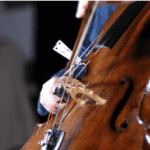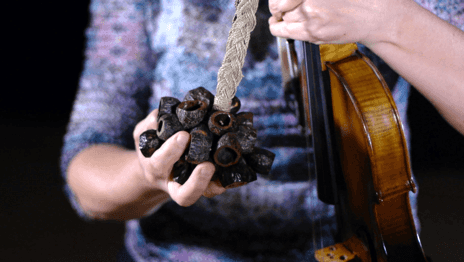The Solos for strings and bass
Performing the Solos for strings and bass
John Cage, Solo for Violin 1 (page 11)
Aisha Orazbayeva
John Cage, Solo for Violin 2 (page 23)
Hilary Sturt
John Cage, Solo for Violin 3 (page 37)
Ruth Ehrlich
John Cage, Solo for Viola 1 (page 64)
Bridget Carey
John Cage, Solo for Viola 2 (page 74)
Reiad Chibah
John Cage, Solo for Cello (page 94)
Anton Lukoszevieze
John Cage, Solo for Bass (page 165)
Jonathan Heilbron
Introduction
In contrast to the other instrumental parts, which are 12 pages in length, the string parts are 16 pages in length, and (excluding the Solo for Bass) they all include the instruction: ‘No part once played is to be repeated’. The parts are some of the sparsest of the Concert, with the fewest number of events per page, on average, though the Solo for Cello contains a page with the fewest sounds (zero, as does the Solo for Violin 2, Solo for Viola 1, and Solo for Sliding Trombone) and the most (36). In addition, the string parts are unique in omitting the suggestion that additional silences may be included in a performance. In a letter to Stuart Dempster in 1974, Cage described the string parts as ‘mediocre’ (John Cage to Stuart Dempster, 24 July 1974 (source: John Cage Collection)); and while they feature regularly in ensemble performances of the Concert, the Solo for Cello is the only string part to have been recorded as a solo piece (by Frances-Marie Uitti on Works For Cello, 1991, and Friedrich Gauwerky, John Cage – Solo for Cello, 2007). There is also a commercial recording of the Solo for Viola performed with the Solo for Flute, titled ‘Duo’ for flute and viola by Franco Carabelli (flute) and Pina Lercari (viola) (Rumori alla Rotonda, 1999)
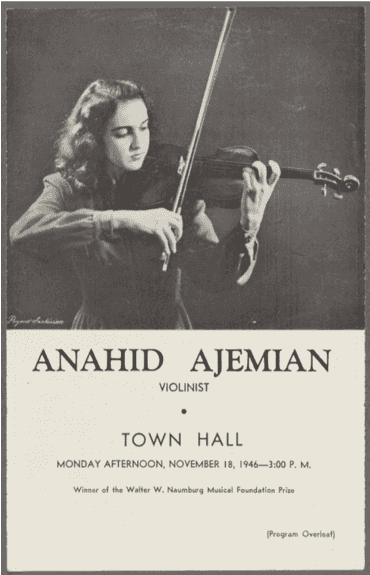
Of the string players who first performed the Concert, it is likely that Anahid Ajemian, who played violin 1 in the first performance, had the most influence over the techniques that Cage used in the parts. Ajemian was a virtuoso violinist and a prominent performer of new music. She had performed several of Cage’s works before the Concert (Nocturne for Violin and Piano (1947) and the Sixteen Dances (1950–51)), and in later years played other pieces including String Quartet in Four Parts (1950–51). Ajemian was also an unofficial ‘fixer’ for several of Cage’s concerts. In 1957, with her husband, the record producer George Avakian, she ran a series of new music concerts, Music For Moderns at New York Town Hall, which featured a programme of jazz, classical, and gospel music.
The rest of the string section comprised chamber, orchestral, and studio musicians. Isidore Cohen (violin) was a member of the Juilliard String Quartet and the Beaux Arts Trio, and worked at Juilliard from 1958 to 1966. Alan Martin (violin) was a member of the Beaux Arts Quartet. Burton Fisch (viola) was a freelance musician who played in the CBS Orchestra for many years, and gave the first private performance of Bartók’s Concerto for Viola in 1948, before its first public performance in 1949. William Gromko (viola) was a studio musician who performed with the Radio City Music Hall Orchestra and various other orchestras before moving to Las Vegas in 1959. Little is known about Joan Brockway (cello), other than she seems to have been primarily a classical musician. The double bassist, Jesse Teiko, performed in Broadway shows, ballets, and was a long-term member of the Met Opera Orchestra at Lincoln Center.
Scordatura
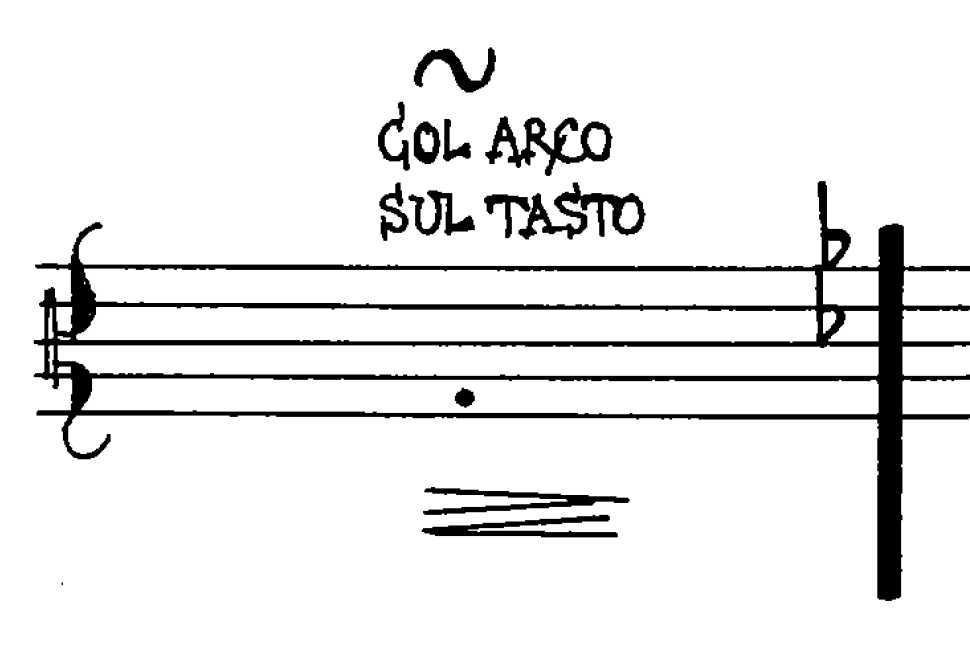
One of the most striking aspects of the string parts is their use of different scordatura. These are indicated by a bar line, which in the woodwind and brass parts usually indicates a change of instrument or reed (as in the case of the clarinet). The instructions state that a sharp or flat relate to an increase or decrease ‘of any amount of tension’, and a natural sign signifies ‘a return to normal (approx.) tension’. The lack of specificity in terms of pitch adjustment perhaps reflects the challenge of retuning the instrument quite quickly in a performance, without necessarily having the time for the player to check the result before playing. Because of this, it’s likely that the instrument will become progressively detuned as the piece unfolds. In addition to changing the instrument’s pitch, scordatura also affects its overall sonority and resonance. The effect also destabilises the instrument, and as Ehrlich explains, can cause other strings to slip, or in extreme cases, snap. Players took different approaches regarding how far to increase or decrease the tension of the string. On the cello, Lukoszevieze chose to adjust the tuning using the fine tuners on the tailpiece rather than the pegs, because they can adjust in smaller increments and they tend to be more stable than the pegs. Heilbron only adjusted the tuning of his bass by very small increments, as he was cautious about snapping the strings.
Since the scordatura is never applied twice in a particular direction (i.e., if a string is sharpened, it is only ever flattened subsequently), this suggests that the pages should be read sequentially. However, some players (e.g., Carey) chose to reorder their pages. As a consequence, she decided to ‘reset’ the tuning at the top of each page, to avoid over-tuning a string to the point that it snapped. Like the dismantling of the instrument in the Solo for Sliding Trombone and the Solo for Clarinet, the scordatura can also bring a theatrical element to the performance. Conrad Harris, who has performed the violin part in S.E.M. ensemble performances of the Concert, commented: ‘You do get some excess noise but I kind of like that. You hear the peg going ‘Krrk’ and then you ‘krrk’ get it back to natural. But I like that’.
Mutes
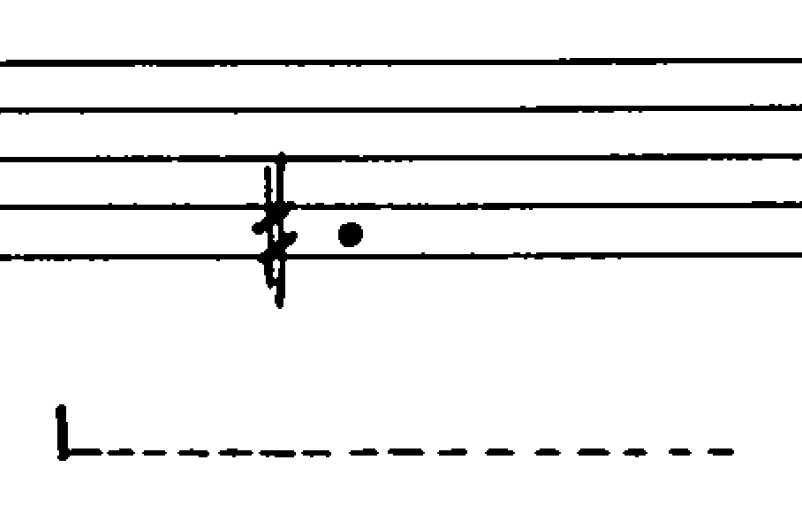
Like some of the wind parts, Cage provides a dotted line under the stave to indicate use of a mute, and suggests: ‘If several different mutes are available, number them and use them to vary the sounds’. The bass part is distinct in this respect, as the instructions state: ‘3 mutes are used and the player is free to number them’ (the mutes are numbered in the part, in the same way as they are for the brass parts). Writing about the Solo for Bass, Bertram Turetzky (1974) identifies Cage as the only composer to have used different mutes in this way.
Most of the Apartment House musicians used at least two or three mutes. Chibah used a standard rubber viola mute and a metal practice mute. He predetermined which mutes to use in advance, and based the decision of which mute to use on the musical material he was playing: he only used the practice mute on the quieter notes. Similarly, Ehrlich allocated the mutes according to the character that she perceived in the material at that point in time (e.g., a stronger practice mute for the more ‘subdued’ sounds) and also practical considerations such as how much time was required to change mutes: for the busy sections, she chose a standard mute that sits on the strings and is more easily accessible. Heilbron chose a standard orchestral mute and a rubber practice mute, and for the third mute he used a stretchy strip of rubber which he threaded between the strings and bridge of his bass. Orazbayeva used three mutes: a rubber mute, a leather mute, and a rubber practice mute. As she pointed out in interview, some of the mutes are used in combination with other techniques (e.g., col legno) which render them redundant. There are also moments in her part, violin 1, (e.g., p. 11) where the rapid changes between mutes become quite theatrical.
Dynamics
In addition to the use of different sized noteheads, which are indicative of either dynamics or durations of a sound, or both, the majority of bowed pitches have dynamics assigned to them. Other than the Solos for violin 1 and violin 2 (which have roughly equal numbers of crescendo and diminuendo indications), these are overwhelmingly biased towards crescendos and combinations of dynamics, these latter being a ‘combination of two or more’ crescendos and diminuendos. The player is free to choose the ‘intensity and duration’ of these, and the overriding character, then, is one of change and improvisation with respect to dynamics throughout the Solo.
Vibrato
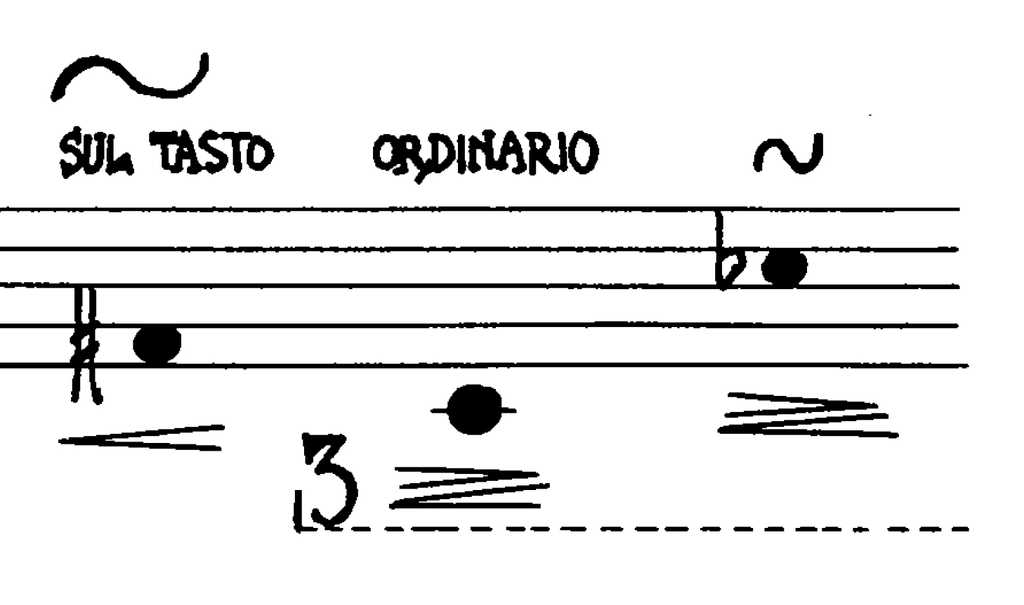
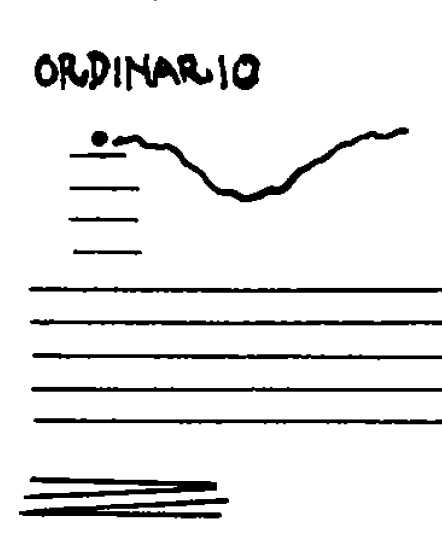
Like the Solo for Tuba, in the string parts Cage’s instructions concerning vibrato specify that all tones should be non-vibrato, however, the violin, viola, and cello parts include the caveat: ‘unless accompanied by wave like signs indicating speed of vibrato. Width of vibrato may be freely varied by the performer.’ The instructions in bass part, on the other hand, differ slightly in that the wave-like signs relate to width rather than speed. Four different kinds of vibrato signs are used throughout the string parts, from a stretched, tilde-like indication to a denser pattern of four oscillations (the Solo for Bass, however, only uses the first two of these signs to indicate slow and medium widths). Vibrato is only applied to bowed pitches.
Sometimes vibrato is used in combination with another technique, e.g., a glissando. Sturt described taking off her left thumb, to allow her hand to move more freely up and down the neck of the violin. By contrast, Lukoszevieze employed vibrato at the start of the sound only, before moving through the glissando without any. In the bass part, vibrato is sometimes combined with harmonics, which is challenging, since the movement disrupts the stability of the partial. Heilbron overcame this challenge by gently tapping the string with his finger to make an intermittent sound, rather than keeping the finger on the string and moving it.
Pizzicato

The string parts require a wide range of pizzicati (the violin, viola, and cello parts have four and the bass part has five). Cage describes the pizzicato as follows: ‘., normal; plus-sign, stopped against fingerboard; x, stopped sideways against fingernail; arrows, slide following attack.’ The fifth technique (for bass) is indicated with the word ‘slap’ and is described in the instructions as ‘slap following pizz.’.
The ‘normal’ pizzicato, where the string is plucked sideways, usually with the index finger, will be familiar to most players, but as Arditti and Platz (2013, 42) point out, a variety of different sounds can be achieved ‘by the choice of which part of the right index finger you use, and the left hand pressure’.
The ‘+’ pizzicato (‘stopped against fingerboard’) is a bit more ambiguous, as Cage doesn’t specify how the string is stopped against the fingerboard. Most of the Apartment House musicians understood this technique as a ‘Bartók’ pizzicato: where the player lifts the string with their thumb and index finger and lets it slap back onto the fingerboard, creating a percussive ‘slapping’ sound. The strength of the sound is influenced by the pitch of the sound—pitches closer to the bridge, where the string is located further away from the fingerboard, will have less of a percussive sound, as will higher pitches with a shorter string (see Arditti & Platz, 2013 43–45, for a more detailed discussion of the Bartók pizzicato). However, Heilbron, Chibah, and Ehrlich interpreted the sign as meaning a subtler muted pizzicato, where the string is plucked and dampened against the fingerboard with the finger.

The ‘x’ pizzicato (‘stopped sideways against fingernail’) is a more unusual technique, without precedent (it appears later in Ligeti’s String Quartet No. 2 (1968)). Most players interpreted this as plucking the string and then stopping it with the fingernail of the left hand so that it resonates and creates a buzzing sound. Arditti and Platz (2013, 46) describe this as a ‘rattle’ pizzicato. The strength of the sound is influenced by where on the string it’s used, the thickness of the string, and the dynamic level of the sound.
The arrowed pizzicato (‘slide following attack’) is more self-explanatory, and is similar to the ‘microtonal slides’ employed in the woodwind and brass parts.
The ‘slap’ pizzicato used in the Solo for Bass, is where the string is plucked and then slapped against the fingerboard to create a percussive sound (also known as slap bass). This technique has been in use in jazz since the 1920s, and perhaps reflects the jazz influence of the double bassist in the premiere, Jesse Teiko.
Gauwerky also demonstrates various pizzicato possibilities in his masterclass on the Solo for Cello here.
Bowing
The string parts require various different bowing techniques: in addition to ‘col arco’, Cage specifies sul ponticello (playing over the bridge), sul tasto (playing over the fingerboard) and col legno (playing with the wood of the bow). These techniques will be familiar to most players, but sometimes they are made more challenging by being combined with other techniques. The musicians discuss bowing techniques in interview.
String specifications
A feature found in just 15 notes of the Solo for Violin 1 and one note in each of the Solos for violin 3 and viola 2 is the assignation of pitches to specific named strings. Quite why this technique occurs for the most part in the violin 1 part only is a mystery, though it is possible that Cage had Ajemian in mind. The technique is used in the String Quartet in Four Parts and Six Melodies for Violin and Piano (1950), and while there is no apparent evidence that Ajemian performed either of these in the period between their composition and that of the Concert, she was surely familiar with both pieces and had worked closely with Cage. The research team met Ajemian shortly before she passed away in 2016, at the age of 92, and, while her memory of the Concert for Piano and Orchestra was fuzzy she vividly recalled the string technique employed in these pieces which required complex and awkward finger manoeuvres across the four strings of the instrument.
Articulation of sustained sounds
All of the string parts include the instruction ‘Notes given appreciable duration may be played constantly or intermittently (spicc., trills, etc.)’ (a similar instruction appears in the Solo for Clarinet and Solo for Trumpet, but without the technique suggestions). As Ehrlich observed in her interview, the player is constrained by the length of the sound that can be produced by a single bow stroke: the note could be bowed very slowly, or the player could decide to make discrete repeated bows, or anything in between. In most cases Ehrlich chose to do a tremolo on a single note, or a trill, both of which can be sustained for a long duration. Chibah used a ricochet bow, spiccato and tremolo. Orazbayeva sometimes played long notes with a diminuendo using a moderately repeated bow, and some spiccato and tremolos. She described trills as ‘too Baroque!’.
Sliding tones
Sliding tones are a common instruction across the instrumental parts. Cage writes ‘Curves following notes are sliding tones. They do not refer to time-length but only to direction in pitch.’ As with the notehead sizes, where a large notehead does not necessarily indicate a loud sound, so here a long sliding tone indication does not necessarily indicate a prolonged glissando, and could instead by read as a very short duration, taking in the various curves and indentations as quickly as possible. Chibah determined the length of the slide by the size of the notehead.
Noises
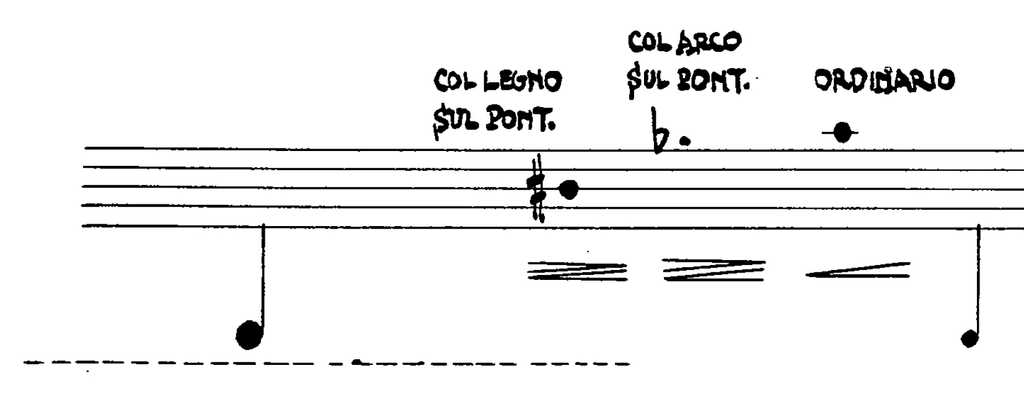
Like all of the instrumental parts, in the string parts Cage suggests noises to be played where stemmed notes below the stave are indicated: ‘noises to be produced on the box of the violin (by percussion or friction) or on any auxiliary sound producing means (e.g. percussion, mechanical, electrical, wind means, etc.).’ Lukoszevieze interpreted ‘friction’ as meaning friction on the string: one approach he took was to attach a clothes peg to one of his cello strings before bowing it, to create an unpitched, reverberant scraping noise. Chibah and Carey produced similar, but subtler unpitched bowing noises without using a clothes peg, and as Carey observed, this was particularly useful for longer durations. Heilbron decided to use a gentle ricochet-bowed, unpitched sound, which again could be sustained for a long period of time, and could be easily adjusted in terms of dynamics. Ehrlich created an unpitched ‘friction’ noise by bowing right on the bridge of her violin, and Orazbayeva chose to bow her rubber mute, which resulted in a low-pitched squeak. Carey used the binding of her bow to bow the strings of her viola, creating a high-pitched scraping noise.
Most of the players interpreted the ‘percussive’ noises as suggesting tapping the body of the instrument in some way. Carey gently tapped her viola in various places with her hands and fingers. Lukoszevieze used the end of his bow to tap the string, bridge, or tailpiece, particularly for small notehead noises. Chibah chose to tap his music stand with a mute. Some of these choices were pragmatic: Dario Calderone, who plays double bass on the recording, John Cage: Dream (2009), commented during interview that during fast passages, ‘there was no other possibility than tapping on the instrument’.
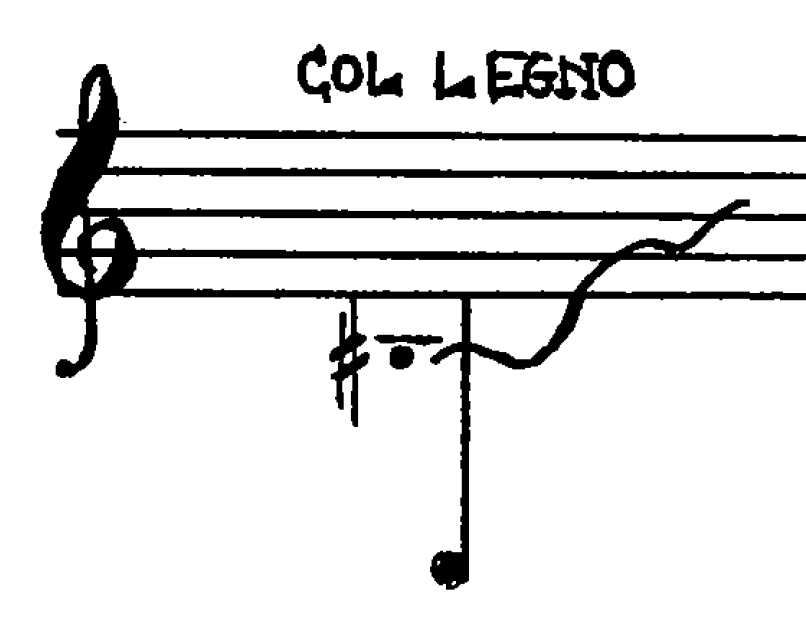
In terms of auxiliary noises, Sturt and Carey used hand-held percussion instruments including a seed shaker, and Ehrlich used a small tambourine. Some of these needed to be operated by foot, depending on what else was happening during the performance at that point. For the one instance of a noise being combined with another sound in the cello part (p. 93, line 3) Lukoszevieze chose to gently blow a whistle, which was relatively easy to combine with other cello sounds.
In the existing recordings, Gauwerky tends to use various percussive sounds for noises by tapping the body of his cello in different places. He also demonstrates similar noises here. In her recording, Uitti mainly uses scratching noises, and some gentle percussive taps on the body of her cello.
Combining techniques
While isolating each technique in the Solos enables a better understanding of the range and detail of techniques Cage used, the real character of each part is revealed in the ways various ways that these techniques are combined. Often one technique may affect another, make another inaudible, or combine with others to create unpredictable and unstable sounds. Performers must constantly navigate the range of options available to them in these cases and make choices as to what, and how, to prioritise in the execution of each sound. The Apartment House String players demonstrate various combinations of techniques in interview.
Acknowledgements
With thanks to Anahid Ajemian, Dario Calderone, Conrad Harris, Seth Woods for sharing their experiences of performing the string parts with the research team.
Bibliography
Irvine Arditti and Robert Platz, The Techniques of Violin Playing (Kassel: Bärenreiter, 2013)
Friedrich Gauwerky, Masterclass for John Cage’s Concert for Piano and Orchestra, 6 April 2012
Bertram Turetzky, The Contemporary Contrabass (Berkeley and Los Angeles, CA: University of California Press, 1974)
Discography
John Cage: Dream. Fabrizio Ottaviucci, piano; Mike Svoboda, trombone; Manuel Zurria, flute; Aldo Campagnari, violin; Giorgio Casati, cello; Dario Calderone, double bass; Nextime Ensemble, percussion, Stefano Scodanibbio, conductor (Wergo, WER 6713-2, 2009)
John Cage – Solo for 'Cello. Friedrich Gauwerky, cello (Wergo, WER 6693 2, 2007)
Rumori alla Rotonda. Franco Carabelli, flute; Pina Lercari, viola (Alga Marghen, VA 11NMN.031, 1999)
Works For Cello; Lecture On Nothing. Frances Uitti, cello (Etcetera, KTC 2016 [1991])
The works of John Cage are the copyright of Henmar Press Inc., New York and are reproduced by permission of Peters Edition Limited, London. All rights reserved.

